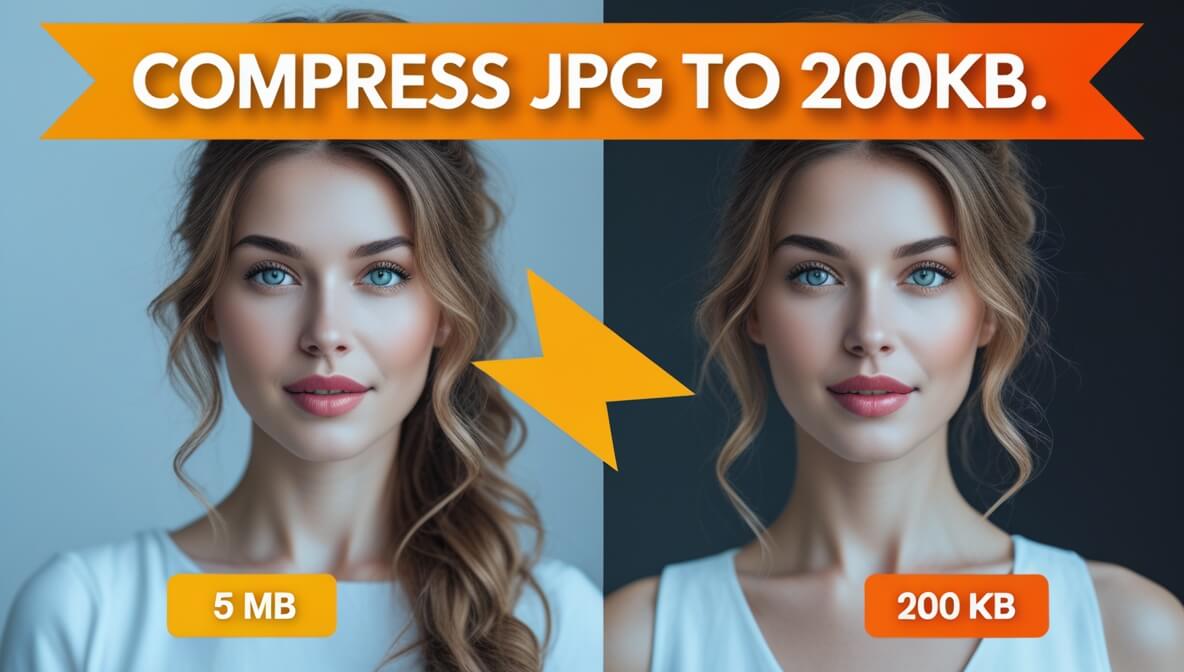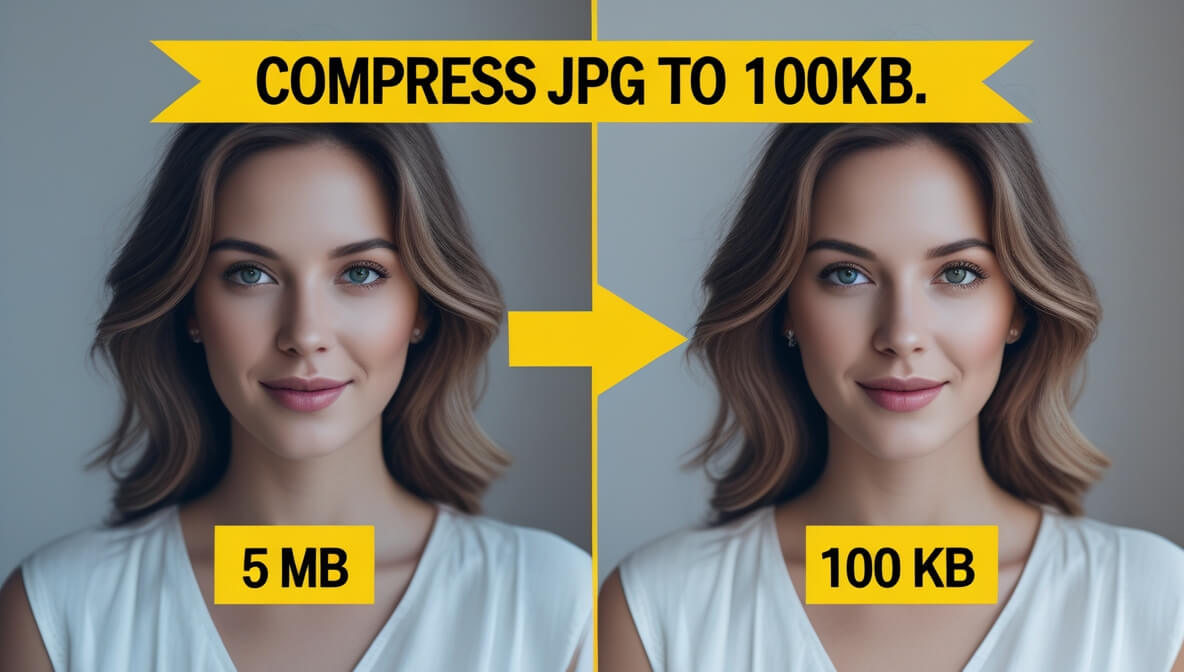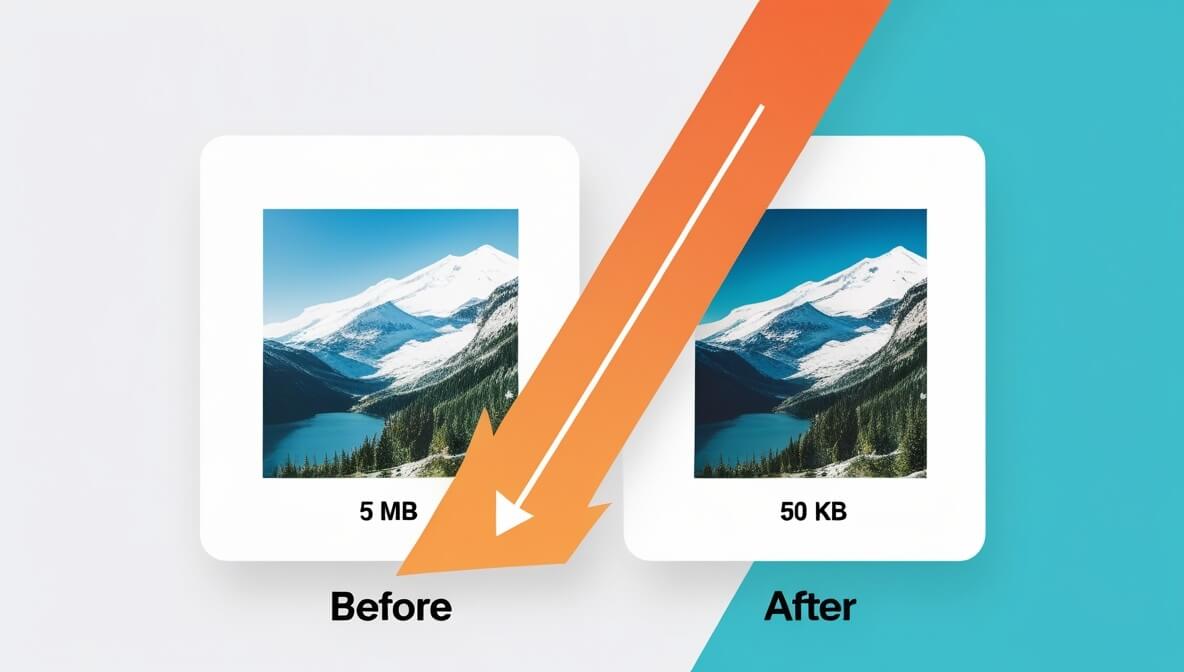In today’s digital age, being able to jpg compress 20 kb is incredibly useful. Whether you’re uploading a passport photo, sending application documents via email, or just trying to save space on your smartphone or computer, learning how to jpg compress 20 kb can make your life much easier. You might have encountered issues like “file too large” or the dreaded, “please upload images under 20 KB,” which can be frustrating if you don’t know how to quickly reduce file sizes.
Thankfully, clear and reliable solutions are available to jpg compress to 20 kb, and you don’t need to be a tech wizard to master them. Having compressed hundreds of JPG images myself for various projects, I’m well aware of the little tips and tricks that can not only save space on your device but also preserve image quality as much as possible. Let’s dive right in and talk about how to compress jpg 20 kb and why this skill might come in handy for you.
Why Compress JPG Images to 20 KB?
When you compress jpg file to 20 kb, you’re essentially reducing the overall size of the image without making it unusable. One of the main advantages is cutting down on storage space. It may not seem like a big deal if you just have one or two large images, but once your gallery starts stacking up, huge image files can quickly clog up your phone or your computer storage.
It also helps bandwidth usage. Images that are too large can take a long time to send as email attachments or messages, or to upload on websites. Compressing them ensures that platforms load them quickly, especially if you compress jpg to 20 kb. This is vital for websites that rely on rapid loading speeds for better user experience and search rankings.
Moreover, many official online application portals, from job sites to government services, require your images or photographs to be below a certain size threshold. Often, that threshold is around 20 KB. Knowing how to jpg compress under 20 kb can save you tons of frustration, allowing you to meet those strict upload guidelines without having to retake the photo entirely.
Benefits of JPG Compression Under 20 KB
One major benefit of compressing your JPGs to below 20 KB is ease of sharing. Suppose you frequently send documents and images via email: an uncompressed photograph might be upwards of 2 MB or more. That can slow down your sending and potentially cause your email to bounce if there’s an attachment size limit. Once you compress jpg 20 kb, you’ll find it much easier to handle attachments on email services, social media platforms, or messaging apps.
Another important plus is improved website performance. If you’re a website owner or blogger, you probably know that visitors can get impatient if your site takes more than a couple of seconds to load. Large images can hamstring page performance. By compressing jpg below 20 kb, you can keep your pages light and fast, improving user engagement and search engine optimization (SEO).
And let’s not forget organizational benefits. If you keep photo archives—maybe you’re a photographer or you run an online store—having your images neatly compressed without sacrificing too much quality is a huge plus. This makes backups and database maintenance far more manageable, even if you only want jpg compress 20 kb to 50 kb for slightly lighter images.
Methods to Compress JPG to 20 KB
- Free Online Compression Tools
The simplest route for most people is using an online image compression tool. A popular search often encountered is “Tools Gear Compress JPG Online” referring to platforms that can shrink images down to the desired file size. Usually, these websites let you upload your file, pick a target size (like 20 KB), and then automatically optimize the image. It’s a one-click solution that doesn’t require advanced knowledge. - Desktop Software
If you want something more robust, you can turn to software like Adobe Photoshop, GIMP, or other dedicated image editors. The process involves adjusting quality settings, dimensions, and compression levels. For instance, you can use a “Save for Web” feature in some programs and specify the required file size (i.e., compress jpg in 20 kb) while viewing a preview of what the image will look like. Many professionals prefer these tools since they allow for fine-tuning. - Mobile Apps
There are also apps on Android or iOS that let you compress images right from your phone. These apps can convert or compress jpg image to 20 kb in seconds. They usually come handy if you’re on the go—maybe you need to send an important document quickly and only have your smartphone. Just open the app, pick your image, and select the output size.
No matter which method you choose, pay close attention to the final quality. Very high compression might lead to pixelation or blurriness. The ideal goal is to compress jpg file to 20 kb while still preserving enough clarity, especially if you need to read text or see important details in the image.

Tools Gear JPG Compress Online vs TinyPNG
Tools Gear JPG Compress Online stands out for its user-friendly interface, lightning-fast processing times, and advanced compression algorithms that consistently deliver high-quality results while maintaining minimal file sizes. It supports batch uploads, enabling users to optimize multiple images within seconds. In contrast, TinyPNG also provides decent compression but lacks some customization features, occasionally results in color shifts. Furthermore, Tools Gear places user privacy first, ensuring immediate deletion of uploaded files and offering secure encryption. Meanwhile, TinyPNG maintains a basic approach with fewer advanced settings. Consequently, Tools Gear JPG Compress Online emerges as a highly reliable, faster, and more customizable solution.
| Criteria | Tools Gear JPG Compress Online | TinyPNG |
|---|---|---|
| User Interface | Crisp, intuitive, and user-friendly | Simple design but fewer customization |
| Batch Uploads | Allows multiple images at once | Limited multi-file handling |
| Compression Quality | Advanced algorithms for minimal quality loss | Great, though occasional color shifts |
| Speed | Lightning-fast processing | Slower on larger images |
| Privacy | Immediate deletion, secure encryption | Standard approach, less clear disclaimers |
| Extra Features | Various customization and editing options | Primarily focuses on compression only |
How to Maintain Image Quality When Compressing JPG to 20 KB
Maintaining quality is undoubtedly one of the biggest concerns people have when they want to compress jpg to 20 kb. It doesn’t help if your final image turns out so blurry that it defeats the purpose of an identifiable or presentable photo.
First, consider resizing your image’s dimensions. The higher the resolution, the bigger the file size. By merely scaling down the resolution to more modest dimensions—like 800×600 or even smaller, depending on your needs—you can drastically reduce the file size before applying compression. This is a good measure, especially if the site or platform you’re uploading to only displays the image at a small size.
Next, look at incremental compression settings. If you have access to an editing tool, start at a moderate compression level—say 70–80% in software like Photoshop. Check the resulting file size. Then gradually push the compression higher (to 50–60%) if you still need the image to be smaller. Visual checking is crucial: once you see the image losing too much detail, you might want to back up a step. This approach is highly recommended for tasks like jpg compress 20 kb to 50 kb, offering more breathing room if you don’t need it as small as 20 KB exactly.
Finally, be mindful of the image’s content. A detailed photograph will typically require more data to retain its clarity than a simple graphic or text-based image. So if you’re dealing with complex visuals, consider cropping intentionally. Cutting out unnecessary background might help a lot in diminishing the file size while maintaining the essential details of the focal point.
Real-World Applications of 20 KB JPG Compression
A typical scenario involves official documentation, like uploading your headshot on a job portal or a government website. These sites often specify you can only upload a photo of, say, 20 KB or 30 KB. Understanding how to compress jpg 10 to 20 kb spares you the hassle of repeatedly uploading an image that gets rejected for being too big.
Another real-world scenario might be digital marketing. If you run an online shop or blog, it’s no secret that large images can slow your pages down. There’s stiff competition out there, and search engine algorithms often reward faster websites with better rankings. When you compress jpg online to 20 kb, you enhance your loading speed, which can translate directly to improved user satisfaction and higher conversions.
And let’s say you’re sending event photos to a friend or a family member via instant messaging. Some messaging apps compress images automatically, but you might prefer fine-tuning the compression to ensure the picture remains decent. Using a quick fix like “compress 20 kb jpg with an app,” you can maintain your control over how the final image appears once delivered.
Common Mistakes and Troubleshooting Tips
One of the most common mistakes is to compress an image repeatedly using different software. If you jpg compress below 20 kb, save it, then open that compressed file again and compress it further, you’re compressing an already compressed file. Each pass can degrade the image quality more than you might expect. Ideally, you want to always start with the highest-resolution version of your picture before using a single compression process.
Another pitfall is ignoring the preview feature. It’s crucial to check how your picture looks before finalizing the compression—especially if you want to compress jpg 10 to 20 kb. A preview let’s you see potential problems like heavy pixelation or color banding on gradients. This is especially important for images containing text, logos, or fine details that must remain legible.
Lastly, some people forget that dimension adjustments can reduce file size even before applying compression. While the file size might still be bigger than necessary, combining dimension reduction with moderate compression is often the key to achieving a compress jpg into 20 kb sweet spot. Pay attention to both factors to strike an optimal balance.
Additional Considerations for Mobile and Tablet Users
If you happen to be using your mobile phone or tablet for the majority of your content creation and sharing, don’t worry—most popular image compression apps are quite user-friendly. Many of these apps have presets labeled “E-mail,” “Social Media,” and so on, giving you a quick guess on the resulting size. The next time you search “jpg compress 20 kb to 50 kb app” on your app store, you’ll see a variety of options. Pick one with a good rating and read user reviews to gauge how well it maintains image fidelity.
Mobile data usage is another reason. If your data plan is limited, every megabyte counts. So compressing your images is a practical step before you send them out or upload them. When you compress jpg stack to 20 kb, you’ll keep the usage low and streamline your entire process of sharing visuals with friends, family, or colleagues.
Additionally, people who rely on cloud storage like Google Drive or Dropbox might want to compress their images to save on storage space. Large numbers of uncompressed photos add up quickly, potentially costing you more in subscription fees. Simple steps to compress jpg image to 20 kb can do wonders for your available storage status.
Exploring Different File Formats
While JPG remains king for photographs due to its wide compatibility, consider exploring other file formats if you really need to go extremely small. PNG is better for graphics with fewer colors or elements like text, but not always smaller. Meanwhile, newer formats like WebP can offer even smaller sizes with decent quality. If your platform supports them, it might be worth taking a look.
That said, for the bulk of scenarios that require compress jpg file to 20 kb, JPG remains your mainstay, particularly for maintaining quality in photos. The good news is that many online converters can switch between all these formats seamlessly, so if your final target is always a JPG under 20 KB, you’re in good company with thousands of other users.
Balancing Usability vs. Quality
If you’re compressing an image purely for identification purposes, like a small mugshot on a form, you can typically afford more aggressive compression and smaller dimensions. If, however, you’re compressing a product photo for an online store, you’ll likely want to keep a slight margin above 20 KB in order to preserve the crispness and detail that potential buyers might want to see.
Balancing usability vs. quality is where many people get stuck. The best approach is trial and error. Experiment with different compression levels and see which final file size is acceptable. Some online tools and desktop software even have a “target file size” feature where you can literally type in “20 KB” and let the tool do the work. That is the most straightforward way to compress jpg to 20 kb if you don’t trust your own eyeball to gauge image clarity.
Security and Privacy Concerns When Compressing JPGs Online
If you’re using an online compressor, pay attention to privacy policies. You may be uploading sensitive images—official documents, personal photos, or anything you’d prefer to keep confidential. Always ensure you’re using a reputable site. Most legit websites say they automatically remove your files after a short time. If you’re worried, consider installing offline software so your images never leave your local machine.
Moreover, stay alert to pop-ups and ads that might mislead you into clicking something else while you’re compressing. Reputable sites provide a clean interface for easy uploading, reducing the possibility of accidentally downloading malware. Taking these steps ensures the process to jpg compress 10 to 20 kb or jpg compress below 20 kb is stress-free and safe.
Conclusion
Compressing a JPG down to 20 KB can drastically improve your digital workflows, from making it easier to upload official documents to optimizing the performance of your blog or website. It’s all about finding a balance between file size and image clarity, whether you rely on online tools, desktop software, or mobile apps. With the methods and tips summarized above, you’re now well-prepared to tackle any jpg compress 20 kb challenge.
Remember, the next time you’re faced with file-size limits or just want to keep your photo collection neat and tidy, a bit of compression will go a long way. Go ahead and give it a try with your own images. You’ll soon see how straightforward and rewarding it can be to compress jpg 20 kb!
FAQ
Q1: How to compress jpg file to 20 kb?
To compress your JPG file to 20 KB, you can use an online platform such as Tools Gear Compress JPG Online. Simply upload your image, choose the target size of 20 KB, and the tool will compress it for you. Make sure to preview the final result to see if the quality remains acceptable, especially if it’s a photo with important details.
Q2: How to compress jpg image in 20 kb?
If you want to compress a JPG image to exactly 20 KB, head over to a reliable site like Tools Gear Compress JPG Online and upload your file. Select 20 KB as the target output size, and let the tool handle the optimization. You can also reduce the dimensions of your image before compression to maintain higher clarity within that 20 KB limit.




